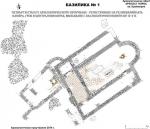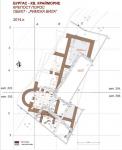Summary (English)
POROS (Milen Nikolov – m_kotlenski@abv.bg) A corner of a building was discovered close to fortification Tower No. 2. Sherds of the Roman period and Late Antiquity, coins of Septimius Severus, Theodosius I, and Justin II and Sophia were found. A three-naved, single apse basilica with a narthex of the 6th century AD was explored to the north of the fortification wall. It was 20.50 m long and 14.40 m wide. The entrance of the narthex was 1.75 m wide and the entrance from the narthex to the nave was also 1.75 m wide. The narthex was paved with bricks. The northern aisle was 2.10 m wide, the southern aisle was 2.40 m wide and the nave was 6.10 m wide. The nave was paved with terracotta tiles, 43 cm by 43 cm in size. A marble column with spiral cannelures and two bases for columns constructed of bricks were discovered in the southern aisle. A grave of bricks, 45 cm wide and 1.90 m long, with a Christian burial was discovered under the floor of the nave. The dead was a man. Seven coins of the end of the 4th – 5th centuries AD were found in the earth that filled the burial pit. A pit was discovered under the floor of the nave, located at 1 m to the northwest of the grave, containing over 300 coins of the end of the 4th – 5th centuries AD minted by Theodosius I, Arcadius and Honorius. The foundation of a pillar that supported the altar table was discovered in the apse. A chamber that accommodated a reliquary was discovered under the foundation of the pillar, filled with fragmentary bricks and fragments from marble altar rails. A lead ampoule for chrism was found close to the chamber. Sherds of the end of the 5th – 6th centuries AD, a follis and a pentanummium of Justin II and Sophia were found in the basilica. A building constructed in rubble masonry that was partly destroyed during the construction of the basilica was discovered to the west of the narthex. A dolium dug into the floor was discovered and an amphora, a quern, terracotta lamps, coins of Theodosius I, Arcadius, Honorius and Theodosius II were found. The building was burned during the AD 420s – 430s. The explorations of the villa continued. It was built in c. AD 250 and existed until the AD 320s. A praefurnium and a hypocaust were discovered in the villa and coins of Severus Alexander, Valerian, Cornelia Salonina, Constantine the Great and Licinius II, the latest ones minted in AD 318 – 324, were found. Two buildings were constructed in the beginning of the 6th century AD over the remains of the villa and they existed until the beginning of the 7th century AD. Sherds from amphorae, coins of Justinian I, Justin II and Sophia, and Phocas were found under the collapsed roof in the southern building. Sherds, including from amphorae, and 53 coins (a follis and nummi minimi of Anastasius I Dicorus and two nummi minimi of Justin I) were found in the lower layer in the southern building.
- Milen Nikolov - Regional Museum – Burgas
Director
Team
Research Body
- Regional Museum – Burgas






![Download [PDF]](/excavation/skins/fasti/images/results/download_sml.png)
